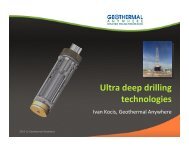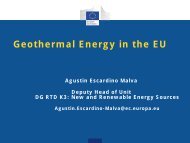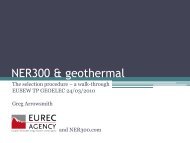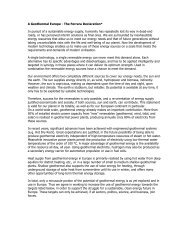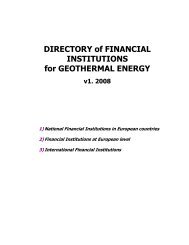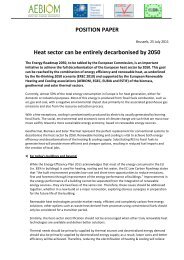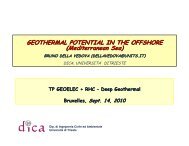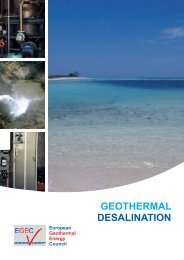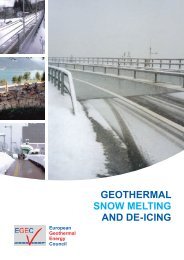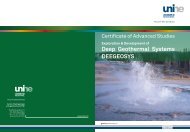Strategic Research and Innovation Agenda for Renewable ... - EGEC
Strategic Research and Innovation Agenda for Renewable ... - EGEC
Strategic Research and Innovation Agenda for Renewable ... - EGEC
You also want an ePaper? Increase the reach of your titles
YUMPU automatically turns print PDFs into web optimized ePapers that Google loves.
<strong>Renewable</strong>Heating & CoolingEuropean Technology Plat<strong>for</strong>m6.3 Priorities <strong>for</strong> Geothermal DHCDeep geothermal energy production is the technology application relevant to this sector,mainly based on direct heat supply by thermal water production <strong>and</strong> reinjection, but alsousing other technology like deep borehole heat exchangers (BHE) or heat from geothermalCHP plants. The capacity of such installations start from about 0.5 MW th (in particulardeep BHE) <strong>and</strong> can achieve values in excess of 10 MW th . The heat is fed directly into adistrict heating system, if production temperature matches the required supply temperature,or it is used as a heat source <strong>for</strong> large heat pumps (including absorption heat pumps,engine-driven compression heat pumps, etc.). Moreover, cold production is possible throughabsorption chillers driven by geothermal heat. Further advancements in DHC technologies(including cascading 67 <strong>and</strong> storage) will make it possible to use geothermal heat moreefficiently. Geothermal technologies suitable <strong>for</strong> DHC networks can also be used <strong>for</strong> largeindividual buildings in the services sector (see Chapter 4) or <strong>for</strong> industrial purposes (seeChapter 5).6.3.1 <strong>Research</strong> <strong>and</strong> innovation priorities with impact in the Short TermGEO.10ObjectiveDeep DrillingThe drilling of boreholes represents a major share of the investment necessary <strong>for</strong> deepgeothermal energy use. Hence reductions in drilling cost can substantially influence theoverall economics of a deep geothermal plant.R&D should focus both on novel drilling concepts <strong>and</strong> on improvements to current drillingtechnology, as well as <strong>for</strong> other ways to optimise the economics of drilling operations 68 .State of the artTargetsType of activityToday drilling <strong>for</strong> deep geothermal energy is done using equipment originally intended<strong>for</strong> the hydrocarbon industry.Reduce cost <strong>for</strong> drilling <strong>and</strong> underground installations by at least 25 % comparedto the situation today.40% Development / 60% DemonstrationGEO.11ObjectiveState of the artTargetsType of activityProduction technologiesImprove efficiency, reliability <strong>and</strong> cost of:• well design <strong>and</strong> completion, including definition of suitable materials• reservoir stimulation, prevention of <strong>for</strong>mation damage• prevention <strong>and</strong> control of corrosion <strong>and</strong> scaling• downhole instrumentation, monitoring <strong>and</strong> logging• efficient production pump technology, submersible pumps <strong>for</strong> high temperatures• production management of the reservoir <strong>and</strong> retrofittingGeothermal well design has reached a good st<strong>and</strong>ard, <strong>and</strong> specifically-designed componentslike pipes <strong>and</strong> pumps are available. Production pumps cause high power consumption.Reduce operation <strong>and</strong> maintenance cost by at least 25 %, improve system reliability <strong>and</strong>energy efficiency of operation, in particular by decreasing energy consumption of productionpumps by at least 50%.30% Development / 70% DemonstrationGEO.12ObjectiveSurface systems <strong>for</strong> heat uses in DHC (incl.CHP)Geothermal applications <strong>for</strong> DHC or large buildings require specific technologies to trans<strong>for</strong>mthe geothermal energy into useful heat to be conveyed through a network or consumed in abuilding. There is scope <strong>for</strong> improvement in the technologies that exchange heat between thegeothermal source <strong>and</strong> the heat transfer fluid in the network, both in terms of energy efficiency<strong>and</strong> resistance to corrosion (e.g. new materials or innovative design).67See Figure 43.68More details <strong>and</strong> possibleR&D-paths are given in thesectorial R&D priorities <strong>for</strong>geothermal technologies:RHC-Plat<strong>for</strong>m (2012b).State of the artTargetsType of activityAny further advancement in DHC technologies (including cascading <strong>and</strong> storage) can improvethe efficiency <strong>and</strong> per<strong>for</strong>mance of geothermal district heating.St<strong>and</strong>ard heat exchange <strong>and</strong> heat/cold distribution systems <strong>for</strong> conventional heat <strong>and</strong> coldsources are applied. The characteristics of geothermal heat (steady supply, mostly limitedtemperature, mineralised waters) determine system’s design, however innovative solutions<strong>and</strong> components are needed.Provide optimum heat transfer from the ground source to the distribution system so to increaseheat exchange efficiency by 25% <strong>and</strong> component longevity in the thermal water circuit by 40%.30% Development / 70% Demonstration67



